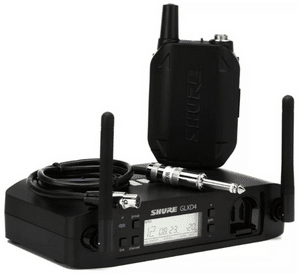
This article will explain what a wireless guitar system is, how to use it, and the pros and cons of “going wireless.” If you are thinking of taking the wireless plunge, check out what I have to say before ditching your instrument cable.
You can use the table of contents below to take you to the area that interests you. Click on the little box to open it and then click on the section of the article you want to read, or you can read from start to finish if you want the full informational experience!
If you are in a hurry and would like to go directly to the advantages and disadvantages section of the article, then click HERE.

What Is A Wireless Guitar System?
Very simply put, a wireless guitar system lets you connect your guitar (electric or acoustic with a pickup) to your sound source without using a guitar cable (cord). It frees you from dealing with the hassle of having your guitar attached to an electrical wire.
These systems can come in all shapes, sizes, technical specifications, and costs. They are used by professional and amateur guitar players alike.
Generally speaking, these systems come in two types, analog and digital. More about that later.
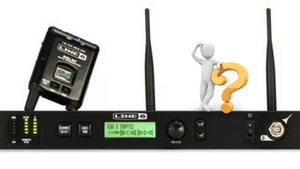
Why Use A Wireless Guitar System?
The main reason guitar players use a wireless hookup is to give them freedom of movement on the stage. If you have ever played in a situation where the stage was cluttered with musical equipment, you know how easy it can be to get your guitar cable tangled up by moving around while you play.
For more reasons, see the section entitled “Advantages Of A Wireless Guitar System.”
How Does A Wireless Guitar System Work?
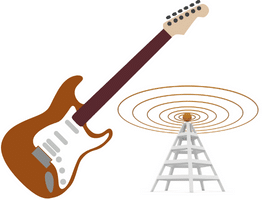
If you are already familiar with wireless guitar systems, you can skip this section; otherwise, read on for a basic description.
A wireless system essentially consists of a transmitter and a receiver. They work together to wirelessly send your guitar signal from your guitar to the next step in your signal chain and ultimately to your audience.
The Transmitter
The transmitter is an electrical device that plugs into your guitar. It changes the electrical signal coming out of your guitar into radio waves and wirelessly broadcasts the notes you play to the receiver.
The distance over which the signal can be transmitted depends on the power rating and quality of the unit.
The Receiver
The receiver recognizes the transmitter’s radio waves from your guitar’s signal. It changes them back to an electrical audio signal that your setup’s next piece of equipment can use.
The wireless receiver can be connected to things like an effects pedalboard, a guitar amplifier, or the PA system via the mixing board.
Analog Versus Digital – What’s The Difference?

Everything is going digital these days, including wireless guitar systems.
Analog wireless still has its uses for guitar, and other musical instruments and systems are still available from Shure, Sennheiser, and Audio Technica.
So, what are the important differences between the two?
Analog Wireless Systems
- Older Technology
- Can be less prone to “dropouts”
- Can be cumbersome to pair transmitter with receiver
- Use “companding” to compress and re-expand the audio signal
- Can “color” your guitar’s tone (due to signal compression)
- No signal latency
- Can have a large number of channels and more bandwidth than digital (good when using a lot of wireless transmitters)
- May require an FCC license
- Can be affected by interference from other nearby radio waves
Digital Wireless Systems
- More resistant to interference
- Can automatically pair the transmitter to the receiver (plug and play)
- Easy to use
- Can be cost effective
- Do not compress and re-expand the signal
- Can have signal latency (cheaper systems)
- Less likely to color your guitar’s sound (no signal compression)
Most likely, a digital unit is the way to go. Still, you need a wireless system that has a good A-to-D converter with a decent transmission range to avoid latency and have a good quality signal that accurately reproduces the sound coming from your guitar.
If you are experiencing problems with latency and signal dropouts, then either go to a more expensive digital unit or try an analog system. Analog might serve you better if there are many wireless instrument signals, like in an orchestral arrangement.
Wireless Vs. Wired, Which Sounds The Best?
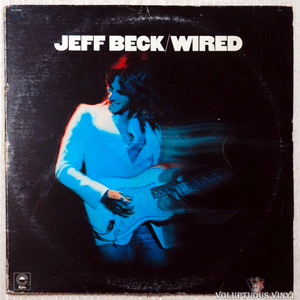
The big question is can wireless give you the same quality sound as wired (using a guitar cable)? One thing is certain; the design and technology for these systems have certainly come a long way!
This is still controversial, but more and more professional guitar players are switching to wireless systems to achieve freedom of movement on-stage and still have an excellent sound.
Some guitar masters, like Jeff Beck, still prefer using a guitar cable. Is it just a matter of being “old school,” or can he really notice a difference in the way his guitar sounds and plays? It’s hard to argue with such an incredible player!

What To Look For In A Wireless Guitar System
Here are some essential things to consider, regardless of the type or brand of wireless guitar system you buy,
Guitar Tone Quality
This is often the number one consideration for selecting a wireless guitar system. Does the unit change the sound of your guitar or the feel of the way the guitar plays?
A wireless digital system may have detectable latency, making you sound out of synch with the other band members, even though you are playing the notes on time. Even if it is too subtle to be detected by the audience, it can change how you play the guitar or how the guitar feels when you play it as you try to compensate for the difference!
Operating Range
At What distance will you need the transmitter to be effective? The operating range can vary from one unit to another, with average distances of 50 to 300 feet, depending on the make and price of the unit.
If you are using the unit at home, for band practice, or playing small venues like a club, you won’t really need to be concerned. If you plan to play on a large stage or take your guitar into the audience, then the operating range can become an important factor!
Frequency Agility
Some of the pricier and more advanced wireless systems have built-in frequency scanning to find the strongest and least noisy frequency band. This can be helpful if you move around a lot over large distances while you play. Frequency agility can be crucial if several wireless systems are being used.
FM (frequency modulation) transmitters in the UHF (ultra-high frequency) range are usually the best choice. Digital transmitters commonly operate at a frequency of 2.4 GHz (Giga Hertz).
Battery Life
Wireless guitar systems typically use disposable AA batteries or have batteries that are recharged through a USB port. Either way, it’s essential to have enough power to play the entire show.
If you want a rechargeable unit, look for a system with at least an 8-hour battery life, just in case you forget to charge it after the previous show.
Durability
Durability is important, especially if the unit will be on the road a lot. Are the transmitter and receiver housings made of plastic or metal? The unit’s reliability is directly tied to its durability.
Reliability
Playing with an unreliable wireless system is never a good bet. Even if it doesn’t fail during the show, it could cause sound dropout, add noise to your guitar’s signal, or even worse – degrade your tone!
Carefully research each wireless unit that you are interested in purchasing. Don’t depend on its reputation as a “top model” or that it’s a pricey system. Read user reviews and talk with other musicians that have used it in a show.
Find out the dealer’s return policy and what type of manufacturer’s warranty the unit carries.
Ease Of Operation
Finally, ease of operation can be important, especially if you set up your own equipment. Systems that feature auto-pairing (plug and play) transmitters and receivers and built-in frequency scanning can make things a lot easier!
Is the transmitter easy to attach and detach from your guitar? Is the receiver easy to connect to and separate from your pedalboard?
Keep Reading To Learn More About Wireless Guitar Systems!
Wireless Transmiter Configurations
There are three basic transmitter configurations for wireless guitar systems. Each of them is built to address a different situation.
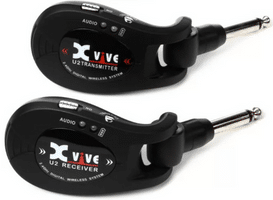
Direct-Into-Guitar Transmitter
This is probably the most straightforward wireless configuration for guitar players. The transmitter is contained in a housing that is small enough to be plugged directly into the guitar’s output jack.
Pros
- It is quick and easy to attach and detach to a guitar
- The best option if you have only one transmitter to share among two or more guitars
Cons
- Changing guitars is not “instantaneous” if you only have one transmitter
- Small size may limit the transmission range and quality of the guitar signal
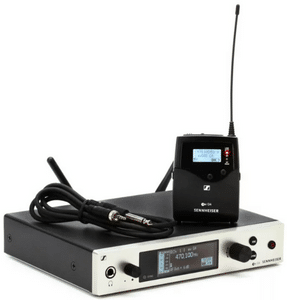
Bodypack-Design Transmitter
These are the units that professionals more commonly use. The player usually has a separate transmitter for each guitar, which typically gets taped to the guitar strap. The transmitter and guitar move as a single unit, so changing guitars is instantaneous.
Pros
- Can change guitars instantly if you have a transmitter for each guitar
- It may also be used for a singer’s wireless microphone
- Transmitter may fit in an effects rack slot or half-slot
- Housing design is large enough to improve transmission range and guitar signal quality
Cons
- Can be challenging to change guitars if you only have one transmitter
- Some units can be really pricey
Pedalboard-Style Transmitter
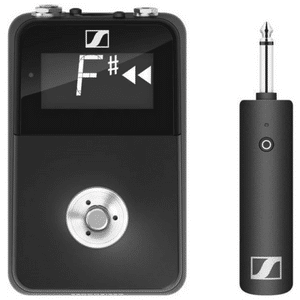
With Guitar Tuner
If you use a pedalboard, then the easiest way to connect your transmitter to your effects going into the front-end of the amp is to use a system that has a pedalboard-style transmitter. The transmitter becomes another box on your pedalboard, and some models can also function as a guitar tuner.
Pros
- Transmitter is safely integrated on effects pedalboard
- Transmitter may have a double function, like a guitar tuner
Cons
- Extra functionality can be pricey
- Transmitter is not designed to fit in an effects rack

Advantages Of A Wireless Guitar System
Here are some of the main advantages of using a wireless guitar system.
Performance Freedom
This is probably the most common reason guitar players decide to go wireless. Having the freedom to move about a large stage without the limitations of a guitar cable can be truly liberating.
Boosts Stage Presence
A wireless system can improve your stage presence in a major way. Look at the stage antics of one of my favorite guitar players, Angus Young from AC/DC! Could he pull off all that running around and spinning on the stage floor without a wireless system? Not on your life!
Accommodates Off-Stage Playing
If you like to walk off stage and into the audience during a part of the show, perhaps to play a guitar solo, then a wireless system can be a Godsend!
I saw Albert Collins play at a small club, where he walked into the audience to do a guitar solo. He was accompanied by two roadies walking alongside him. It took him forever to get back to the stage. Wireless systems weren’t yet available, so there was no other way to do it.
Eliminates Very Long Guitar Cables
Excessively long guitar cables can alter the sound of your guitar due to changes in cable capacitive and inductive reactance. In the story above, Albert had the longest guitar cable I’ve ever seen, but he still sounded great. That’s the “Ice Man” for you, but it’s still something to keep in mind.
Prevents Accidentally Unplugging The Guitar Cable
How often have you stepped on your guitar cable during a solo and accidentally unplugged it? It is so common that guitar players started looping their cable between the guitar and the guitar strap.
Easier Execution Of Guitar Tricks
If you are a flashy guitar player, then a wireless system can make things a lot easier when you play behind your back and twirl the guitar around your body during a solo (try that with a guitar cable).
Electrical Safety
This is an important point! How many times have you gotten zapped while touching your guitar and a microphone? It doesn’t feel good, and it’s dangerous. Tube amps can easily run at over 500 Volts, and the amount of electrical power on a heavily-equipped stage can be a recipe for disaster, so unplug yourself for safety-sake.
Improve Or Eliminate Guitar Cable Ground Loops
Guitar cables can create noisy ground loops under the wrong wiring conditions, even with a properly grounded amplifier. Eliminating the instrument cable can help.
Eliminate Guitar Cable Noise And Faults
All guitar cables become noisy as they wear out and eventually fail. It’s another reason players tuck their cables between the guitar body and strap, to help prevent a faulty guitar plug.
Neater And Cleaner-Looking Stage
Setting up wireless systems for all the musicians on a stage will create a less cluttered stage that is easier to navigate, especially in dark or dimly-lit conditions. Trip and fall accidents can be minimized or eliminated by removing unnecessary cables.

Disadvantages Of A Wireless Guitar System
Wireless systems can have some downsides. Here are some of the things you should carefully consider before buying one.
Sound Quality
Sound quality may be an issue with wireless units, especially cheaper ones. If you have dropouts, noise, interference, or latency issues, you may need to experiment with using an analog versus a digital unit or upgrade to a better model.
Cost
Some wireless systems can be quite costly, depending on what you need for your particular situation. The cost can add up quickly if you play multiple guitars and want a transmitter for each instrument.
The price of batteries for systems that are not rechargeable can also be an issue, especially if you play professionally.
Additional Complexity
Adding a wireless system to your guitar rig puts one more thing in your signal chain that can potentially fail. The simplest setups are sometimes the most reliable.
Batteries
If you forget to charge or change the batteries in your wireless transmitter it could fail in the middle of a song. Make sure to charge the unit before every gig or that you have fresh batteries on hand if it uses external batteries.
Get a wireless unit that can hold a charge long enough to play several gigs, just in case. Some units can hold a charge for up to or over 12 hours of continuous use.
Changing Guitars
If you don’t have a separate transmitter for each guitar you play on stage, it will probably take you longer to change guitars between songs than if you were directly plugged into a guitar cable. This shouldn’t be a problem in most instances unless you play in a very large band or change guitars frequently.
Latency In Digital Systems
Latency is a problem that you could encounter with some of the cheaper wireless digital systems. It is not seen in analog units. Significant latency can make you sound out of synch with the other band members, even though you are playing the notes on time.
Even if it is too subtle to be detected by the audience, latency can change how you play the guitar or how the guitar feels when you play it as you try to compensate for the time differential!

Beware Of These Transmission Requirements!
Please read this notification!
FCC’s Operating guidelines
Some older (predominantly analog) wireless guitar systems operate in the 617-652 MHz or 663-698 MHz frequency range. These units are now transmitting outside the most current FCC operating guidelines and may require a transmission license.
If you are looking for a used wireless system, be aware of these requirements and ask to see the unit’s transmission specifications before purchasing.
Are Wireless Guitar Systems Legit?
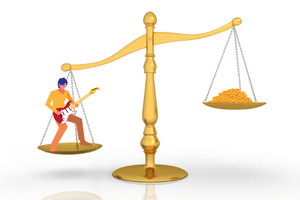
Some of the earliest wireless guitar systems were problematic in terms of guitar signal quality, noise, dropouts, and frequency interference.
Today it’s easy to find a wireless system for every budget that meets or exceeds your needs and expectations.
However, it’s essential to do your product research and try before you buy or make sure you will have the opportunity to return the unit if it is not the right system for you.

Key Takeaways
Here are some of the most important points to remember regarding wireless guitar systems.
- A good wireless system can sound as good as a guitar wired with an instrument cable
- Systems can be digital or analog – most of the time digital is the way to go
- If you buy a digital system, be sure that latency is not a problem
- Transmitter units come in 3 configurations: Direct-Into-Guitar, Bodypack-Design, and Pedalboard-Style
- It’s important to do your research and “try before you buy,” whenever possible

Frequently Asked Questions
Here are some of the most common questions people ask about a wireless guitar system.
If you don’t find what you’re looking for, leave me a comment, and I’ll get back to you with an answer!
What Is The Best Wireless Guitar System?
There is no “Best” wireless guitar system. A better question would be, “what is a good wireless guitar system?”
Many good wireless guitar systems are available from companies like Shure, Line 6, Xvive Audio, Sennheiser, Audio Technica, Samson, Boss, Ibanez, Behringer, and others.
I recommend finding the features you need in a wireless guitar system at a price range that works for you and checking out a few of those units.
Is A Cheap Wireless Guitar System Any Good?
A lower-price wireless guitar system typically has more functional limitations than a more costly one, such as latency, operating range, frequency agility, and ease of operation.
Cheaper systems are fine for most amateur guitar players. Professional players should be more selective about what they require to meet their needs, which can involve systems that are quite costly.
How Does A Wireless Guitar System Work With Pedals?
Any wireless guitar system will work well with pedals. Some companies, such as Sennheiser, make wireless receivers that are specifically designed to be mounted on pedalboards.
For more info about effects pedals, see What Is A Guitar Stomp Box – Attractive, Little, Tantalizing.
Does A Wireless Guitar System Affect Tone?
Although it is possible for a wireless guitar system to affect your guitar’s tone, if the system is carefully chosen for your particular use and set up correctly, it is very unlikely to change the way your instrument sounds and plays in a detectable way.
How Often Do I Need To Change Batteries?
Most of the AA batteries in wireless guitar systems will last for up to 8 hours of continuous use.
Some systems feature rechargeable batteries that are charged through a USB port with a battery life of 4 to 8 hours, while the more expensive rechargeable systems have lithium-ion batteries that can last for up to 14 to 16 hours of continuous use.
What Is The Difference Between 2.4 Ghz and 5.8 Ghz For Wireless Guitar Systems?
The 5.8 GHz systems are more capable of transmitting a longer distance with less radio frequency interference and a higher signal-to-noise ratio.
Can I Use Multiple Guitars With One Wireless Guitar System?
Yes, you can use multiple guitars with one wireless system.
The most cost-effective approach is to have a single transmitter and swap it out each time you change guitars. This can be time-consuming and is not recommended for professionals that use many guitars in the same show.
An easier way to do it is to have a separate transmitter for each guitar, all transmitting to the same receiver on the same frequency. This will allow you to change guitars during a show instantly.
A less common but more costly approach would be to have a separate transmitter and receiver for each guitar to eliminate noise from frequency crossover.
Can You Combine Wireless And Wired Systems On The Same Stage?
Absolutely. This is commonly done and should not be anticipated to cause a problem. Many bands combine both types of systems during a performance.
How Long Have Wireless Guitar Systems Been Around?
The first wireless system appeared between 1975-1976. It was made by Schaffer–Vega Diversity Systems (SVDS). The unit was designed by Ken Schaffer and made in the USA by the Vega Corporation.
This analog device underwent many improvements in sound quality, transmission distance, and frequency agility over the years to bring you the state-of-the-art technologies that exist today.
Do Wireless Systems Cut Out?
Wireless systems can cut out if the transmitter is outside the receiver’s range, if there is a high degree of radio frequency interference or noise, or if battery power is low.
Most wireless systems today are very reliable and unlikely to cut out if best practices for the unit are followed.
Do Wireless Systems Work For Bass Guitars?
Absolutely. Wireless systems work great for bass guitars, and many professionals use them with no issues whatsoever.
Can You Use A Wireless With Active Pickups?
Yes, most higher-end wireless guitar systems (typically $300 and above) are compatible with active pickups. Still, you should check the user manual or directly with the manufacturer to verify that there are no issues.
Systems that are not totally compatible with active pickups may cause audio signal distortion or dropout.

Final Thoughts
A wireless guitar system is composed of both a transmitter and a receiver. These systems come in many different price ranges and configurations to suit any performance situation.
There are generally more “pros” than “cons” to going wireless, but be aware of both sides of the story.
Guitar players who play professionally should seriously consider adopting wireless technology since it is an electrically safe and convenient way to connect your guitar to the rest of your rig.
Those players that need performance freedom for guitar theatrics or want to look cool playing in their band will love the wireless guitar style.

If you play guitar at home for your enjoyment, then chances are you don’t need a wireless system. A high-quality guitar cable will most likely be your best option.

Tell Me What You Think
Please leave a comment below if you enjoyed this article, have any questions about the pros and cons of a wireless guitar system, or want to give your point of view. I will be happy to help you.
- Do you already use a wireless guitar system? Which one? What do you think about it?
- Are you thinking of replacing your wireless guitar system with a new model? Why?
- Do you think a wireless system sounds as good as using a guitar cable? If not, why not?
- Would you find an article on a wireless guitar system review helpful?
- After reading this article are you thinking of buying a wireless system?



A wireless system sounds like the way to go, and specifically I think it would need to be digital. Would there be any interference at all with this? That would be my only concern. I don’t play the guitar, but my son does. His birthday is in May, which is fast approaching. I’d like to get him something for his guitar. Just trying to figure out what that is.
Hi, Leahrae
Thank You for your comments and question!
Digital wireless guitar systems can have some issues with frequency interference, but this won’t be a problem unless your son plays professionally and travels a lot.
If he plays in a band, he will appreciate going wireless. It will definitely give him more performing freedom and always looks cool to audience members!
You can get a low-cost digital wireless guitar system that will work great, and I think he will be pleased with it as a Birthday gift!
You sound like a great mom to me! 😊
Frank
I’ve played the acoustic guitar on and off for about 23 years. Man, that makes me feel old lol. Anyway, I have an acoustic-electric but I’m so technologically challenged that I had always avoided much of the new gear and gadgets. It sounds like this may not be as complicated as I thought and might actually make the setup process much faster at open mics (once I actually start doing them again lol!) I always found it a bit awkward to set up with the AV guys. Do you think this would make it an easier transition?
Hi, Nicole
Thank You for your great comment and question!
Don’t worry about your age. It’s all about playing as much guitar as you possibly can!
Absolutely no cause for concern. You don’t have to be technically savvy to use a wireless guitar system.
All you have to do is plug the transmitter part of the system into your guitar and the receiver component into your guitar amp or mixing board. I’m not sure the setup will be faster than doing the same thing with a guitar cable, but certainly not more difficult.
The AV guys will be OK with a cordless system, so don’t worry about that.
If you always sit while you play, then using a guitar cable should work just as well as going wireless, BUT if you move around the stage, then you’ll love the freedom of not having to worry about the cable holding you back, especially if you go out into the audience while you play!
Get a digital “plug and play” (the transmitter automatically pairs with the receiver) system, and you’re good to go! You don’t have to spend a lot of money but don’t buy the cheapest one.
If your guitar output jack is inside your strap button, get the “direct-into-guitar” transmitter (see the wireless transmitter configurations section in my article). It will plug directly into where your guitar cable goes and not be in the way.
Let me know how you make out here in the comments section.
You sound like a great player, have fun, Nicole! 🎸
Frank
I’m a full time professional musician. I’ve used wireless systems for my guitar for about 30 years. The first wireless system I bought was a Shure diversity. It served my needs flawlessly for many years until it developed an electro/mechanical issue with the transmitter. I reverted to cable for a short period of time then I tried Xvive. This worked but less range and had issues with channel interference in certain environments with multiple 2.4g radio sources. Then the batteries started giving out and they’re not replaceable. I dropped the big bucks on a Shure GLXD16 pedal board wireless. I really like and recommend the Shure products. I play multiple guitars and I attach the body pack to my belt so switching guitars is not too difficult. I could buy transmitters for each guitar but it’s costly. The main reason I selected the GLXD16 is the batteries are user replaceable. If or when the batteries quit holding charge I only have to buy a battery. I get great reception up to 200 feet and it’s much better than other systems in noisy RF environments. Plus it has a built in tuner.
Hi, Peter
I really appreciate your comments!
I’m old enough to remember watching the Peter Gunn series on TV in the late ’50s and early ’60s. ?
My first wireless guitar system was a Shure. It was so long ago that I can’t remember the actual model. I think it was the T1 transmitter with the T3 receiver. It worked for the price but had some noise interference issues, but it used replaceable batteries.
Thank You for your assessment of the Shure GLXD16, which is generally considered to be an excellent unit. I’m glad you like it.
I don’t play pro anymore, so I cable my guitars into amps.
Frank ?
Hey Frank! Thank you for this very helpful article. I’m a professional bassist and have been considering getting a wireless system for more freedom on stage. Aesthetically/logistically speaking, I think I would prefer the direct-to-guitar style transmitter, but my impression so far in my preliminary research is that I would be sacrificing some quality if I went that route, as opposed to the body-pack design. I’m willing to spend some money for a good and reliable product, but it seems like the plug-style options are more in the budget price range. Do you have any recommendations of models or brands in that style that would deliver professional quality, and that would be well suited for an active bass? I don’t need a huge distance range or anything, just concerned about sound quality and latency, and prefer the streamlined convenience of the plug-style models. Thanks!
Hi, JW
Thank You for your comments and question!
Yes, the direct-to-guitar style transmitters are more convenient but not as highly rated or functional as some of the bodypack units, especially for active bass pickups.
I found a great article on Sweetwater entitled “Best Wireless Systems for Bass.” I have emailed the URL to you. You’ll note all the systems in the article are bodypack units. However, that does not mean you can’t get a direct-to-guitar style transmitter that will work for you. Your best bet is to speak with a customer representative at Sweetwater to be sure you get the best unit for your guitar in your budget.
Happy New Year! ?
Frank ?
I disagree with the notion that wireless systems are unnecessary for playing around the house.
For me a wireless system had a big impact on my motivation to play because I was constantly fighting cables. Being able to freely walk around and “noodle” made me work my hand out a lot more because I could leave the room and still run my exercises.
Another thing is I had a brother who played bass and insisted that his bass amp was cranked up to mach 12. It was so damn loud standing with the band that I would often walk outside and play from across the street to equalize the sound levels to my ear.
Also I was constantly killing my cables by stepping on them or routing them under my strap to the jack. Sick of replacing cables!
I have played on stage in front of crowds and everywhere else from the toilet to the street. Losing the cable was the one of the best things I have done to make playing and practicing more enjoyable. I have played for over 30 years now and harder rock is my thing. Take my advice and try a wireless system. I bet you will absolutely love it if you play more than a few minutes at a time.
Hi, Jay
I super appreciate your input!
I have used wireless around the house, too. Many years ago, I had a guitar setup with my Marshall rig and effects board on one side of the room and a comfortable couch on the other. I solved the cable problem with a Shure wireless system.
The story about your brother is hilarious! Haha – I can just picture that! ?
Keep on Rockin’! ?
Frank ?
For those worried about latency let me explain in practical terms. I recently purchased a cheap set on Amazon from Mosh Pit Music. The latency is listed at 10ms. I was concerned but on playing I really can’t hear any latency and then on researching on an electronics site I read than 1ms is equivalent to being 1 foot away from a sound source so 10 ms latency would be like being 10 foot away from your own amp or a drummer. Hence I really can’t detect it cheers Pete
Hi Pete
I agree that latency may or may not be a factor, depending on things like the wireless guitar system, guitar & amp setup, and even the outdoor climate. Experimentation is key!
Rock On!
Frank
Frank, need some advise please. I have a Fender hot Rod DeVille amplifier and have purchased 2 different sets of wireless guitar systems but both are extremely noisy and are unworkable . Plugged the latest one into a different amp and it was perfect. So it seems the Fender amp is the problem. What system would you recommend.
Both the systems I purchased were cheapies, around $80.
Joe
Hi Joe
You’re probably looking at something in the $200 to $300 range, minimum.
Check out the Line 6 Relay G10S Wireless Guitar System With G10TII Transmitter – around $230
The Shure GLXD16+ will set you back about $500
There are many other options between these two wireless guitar systems, but I think the Line 6 system will give you great results.
Rock On!
Frank